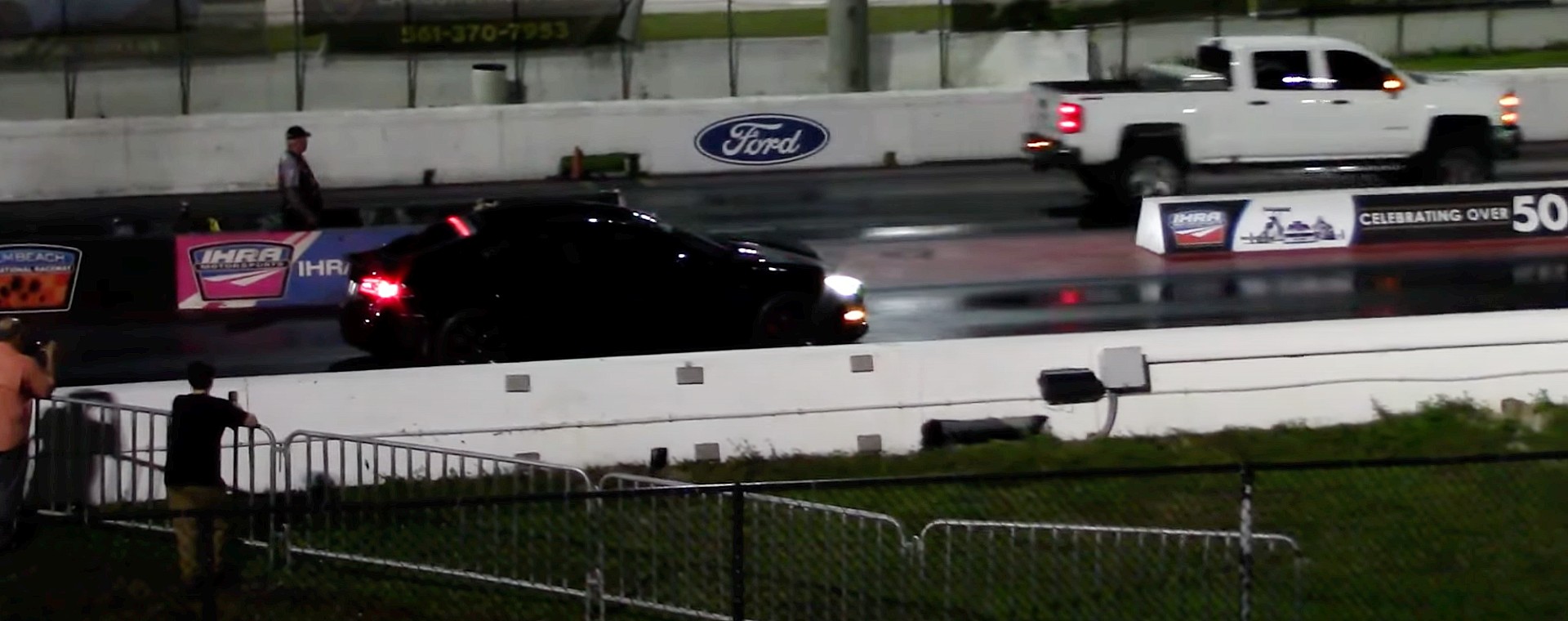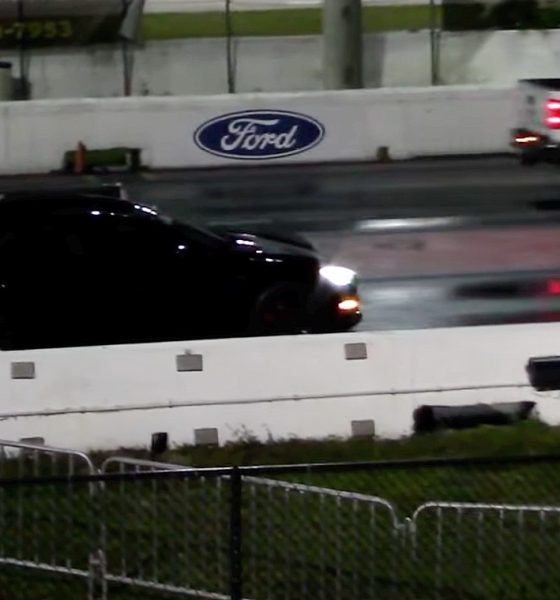

News
Tesla Model S Plaid accidentally starts drag race in reverse, wins anyway
A Tesla Model S Plaid involved in a drag race against a Chevrolet 2600 HD Diesel truck accidentally started the duel in reverse. In typical Plaid fashion, the Model S still won the race.
A video from Drag Racing and Car Stuff on YouTube, shared via InsideEVs, showed a Model S Plaid preparing for a typical quarter-mile drag race against a Chevy diesel truck. As the Christmas Tree of lights funneled from yellow to green, indicating the race had begun, the Model S surged backward mistakenly, as the Chevy took off in the correct direction. Accidentally done by the stalkless Model S, the driver used the touchscreen or brake pedal to override the vehicle’s decision. The Model S recovered, and the instant torque of one of the world’s fastest EVs caught up to and overtook the pickup.
Perhaps one of the most substantial changes Tesla made to the Model S, its flagship sedan, was the entire steering column. Instead of the typical round steering wheel, Tesla chose a yoke. Surrounding it, no stalks, as CEO Elon Musk explained the vehicle would detect the direction of travel automatically based on its surroundings. It’s not perfect, yet, and the Model S made a mistake. It was nothing the powertrain could not recover from. The driver also has to activate the feature for “Auto Shift out of Park,” which can be overridden by pressing the brake pedal or using the touchscreen.
No more stalks. Car guesses drive direction based on what obstacles it sees, context & nav map. You can override on touchscreen.
— Elon Musk (@elonmusk) January 28, 2021
In conjunction with Tesla’s focus on autonomy, the automaker’s vehicles pack plenty of features that many of us could only imagine. As vehicles become more like highly-capable computers, decisions are less likely to be processed by a human and instead are focused on by the vehicle. It is still a work in progress. Tesla vehicles only seem to get smarter with every software update, and they become more accurate in their predictions with every mile driven thanks to its Neural Network.
What’s even more impressive is the Model S Plaid’s ability to recover from a substantial mistake. Granted, a pickup may not be the most ideal solution for a drag race, but it had plenty of advantages off the line. As the Model S crept backwards, the Chevy drove away, only to be caught up to, and eventually passed by the all-electric sedan.
The Model S Plaid has an impressive 1.99-second 0-60 MPH acceleration rate, thanks to the electric powertrain that provides instant torque.
The full video, courtesy of Drag Racing and Car Stuff is available below.
I’d love to hear from you! If you have any comments, concerns, or questions, please email me at joey@teslarati.com. You can also reach me on Twitter @KlenderJoey, or if you have news tips, you can email us at tips@teslarati.com.

News
Tesla Full Self-Driving shows confident navigation in heavy snow
So far, from what we’ve seen, snow has not been a huge issue for the most recent Full Self-Driving release. It seems to be acting confidently and handling even snow-covered roads with relative ease.

Tesla Full Self-Driving is getting its first taste of Winter weather for late 2025, as snow is starting to fall all across the United States.
The suite has been vastly improved after Tesla released v14 to many owners with capable hardware, and driving performance, along with overall behavior, has really been something to admire. This is by far the best version of FSD Tesla has ever released, and although there are a handful of regressions with each subsequent release, they are usually cleared up within a week or two.
Tesla is releasing a modified version of FSD v14 for Hardware 3 owners: here’s when
However, adverse weather conditions are something that Tesla will have to confront, as heavy rain, snow, and other interesting situations are bound to occur. In order for the vehicles to be fully autonomous, they will have to go through these scenarios safely and accurately.
One big issue I’ve had, especially in heavy rain, is that the camera vision might be obstructed, which will display messages that certain features’ performance might be degraded.
So far, from what we’ve seen, snow has not been a huge issue for the most recent Full Self-Driving release. It seems to be acting confidently and handling even snow-covered roads with relative ease:
FSD 14.1.4 snow storm Ontario Canada pic.twitter.com/jwK1dLYT0w
— Everything AI (@mrteslaspace) November 17, 2025
I found the steepest, unplowed hill in my area and tested the following:
• FSD 14.2.1 on summer tires
• FSD 14.2.1 on winter tires
• Manual drivingBut I think the most impressive part was how FSD went DOWN the hill. FSD in the snow is sublime $TSLA pic.twitter.com/YMcN7Br3PU
— Dillon Loomis (@DillonLoomis) December 2, 2025
Well.. I couldn’t let the boys have all the fun!
Threw the GoPro up and decided to FSD v14.2.1 in the snow. Roads were not compacted like the other day, a little slippery, but overall doable at lower speeds. Enjoy the video and holiday music 🎶
Liked:
Took turns super slow… pic.twitter.com/rIAIeh3Zu3— 🦋Diana🦋 (@99_Colorado) December 3, 2025
Moving into the winter months, it will be very interesting to see how FSD handles even more concerning conditions, especially with black ice, freezing rain and snow mix, and other things that happen during colder conditions.
We are excited to test it ourselves, but I am waiting for heavy snowfall to make it to Pennsylvania so I can truly push it to the limit.
News
Tesla hosts Rome Mayor for first Italian FSD Supervised road demo
The event marked the first time an Italian mayor tested the advanced driver-assistance system in person in Rome’s urban streets.

Tesla definitely seems to be actively engaging European officials on FSD’s capabilities, with the company hosting Rome Mayor Roberto Gualtieri and Mobility Assessor Eugenio Patanè for a hands-on road demonstration.
The event marked the first time an Italian mayor tested the advanced driver-assistance system in person in Rome’s urban streets. This comes amid Tesla’s push for FSD’s EU regulatory approvals in the coming year.
Rome officials experience FSD Supervised
Tesla conducted the demo using a Model 3 equipped with Full Self-Driving (Supervised), tackling typical Roman traffic including complex intersections, roundabouts, pedestrian crossings and mixed users like cars, bikes and scooters.
The system showcased AI-based assisted driving, prioritizing safety while maintaining flow. FSD also handled overtakes and lane decisions, though with constant driver supervision.
Investor Andrea Stroppa detailed the event on X, noting the system’s potential to reduce severe collision risks by up to seven times compared to traditional driving, based on Tesla’s data from billions of global fleet miles. The session highlighted FSD’s role as an assistance tool in its Supervised form, not a replacement, with the driver fully responsible at all times.
Path to European rollout
Tesla has logged over 1 million kilometers of testing across 17 European countries, including Italy, to refine FSD for local conditions. The fact that Rome officials personally tested FSD Supervised bodes well for the program’s approval, as it suggests that key individuals are closely watching Tesla’s efforts and innovations.
Assessor Patanè also highlighted the administration’s interest in technologies that boost road safety and urban travel quality, viewing them as aids for both private and public transport while respecting rules.
Replies on X urged involving Italy’s Transport Ministry to speed approvals, with one user noting, “Great idea to involve the mayor! It would be necessary to involve components of the Ministry of Transport and the government as soon as possible: it’s they who can accelerate the approval of FSD in Italy.”
News
Tesla FSD (Supervised) blows away French journalist after test ride
Cadot described FSD as “mind-blowing,” both for the safety of the vehicle’s driving and the “humanity” of its driving behaviors.

Tesla’s Full Self-Driving (Supervised) seems to be making waves in Europe, with French tech journalist Julien Cadot recently sharing a positive first-hand experience from a supervised test drive in France.
Cadot, who tested the system for Numerama after eight years of anticipation since early Autopilot trials, described FSD as “mind-blowing,” both for the safety of the vehicle’s driving and the “humanity” of its driving behaviors.
Julien Cadot’s FSD test in France
Cadot announced his upcoming test on X, writing in French: “I’m going to test Tesla’s FSD for Numerama in France. 8 years I’ve been waiting to relive the sensations of our very first contact with the unbridled Autopilot of the 2016s.” He followed up shortly after with an initial reaction, writing: “I don’t want to spoil too much because as media we were allowed to film everything and I have a huge video coming… But: it’s mind-blowing! Both for safety and for the ‘humanity’ of the choices.”
His later posts detailed FSD’s specific maneuvers that he found particularly compelling. These include the vehicle safely overtaking a delivery truck by inches, something Cadot said he personally would avoid to protect his rims, but FSD handled flawlessly. He also praised FSD’s cyclist overtakes, as the system always maintained the required 1.5-meter distance by encroaching on the opposite lane when clear. Ultimately, Cadot noted FSD’s decision-making prioritized safety and advancement, which is pretty remarkable.
FSD’s ‘human’ edge over Autopilot
When asked if FSD felt light-years ahead of standard Autopilot, Cadot replied: “It’s incomparable, it’s not the same language.” He elaborated on scenarios like bypassing a parked delivery truck across a solid white line, where FSD assessed safety and proceeded just as a human driver might, rather than halting indefinitely. This “humanity” impressed Cadot the most, as it allowed FSD to fluidly navigate real-world chaos like urban Paris traffic.
Tesla is currently hard at work pushing for the rollout of FSD to several European countries. Recent reports have revealed that Tesla has received approval to operate 19 FSD test vehicles on Spain’s roads, though this number could increase as the program develops. As per the Dirección General de Tráfico (DGT), Tesla would be able to operate its FSD fleet on any national route across Spain. Recent job openings also hint at Tesla starting FSD tests in Austria. Apart from this, the company is also holding FSD demonstrations in Germany, France, and Italy.








